Memorial Day history
Memorial Day
“That Nation which respects and honors its dead, shall ever be respected and honored itself.”
– Brevet Lieut.-Col. Edmund B. Whitman, 1868
Memorial Day, a federal holiday held the last Monday in May, is the nation's foremost annual day to mourn and honor its deceased service men and women.
Originally called Decoration Day, it was formalized by a "Memorial Day Order" issued by Grand Army of the Republic Commander-in-Chief John A. Logan in 1868.
The modern proclamation calls on Americans "to observe Memorial Day by praying, according to their individual religious faith, for permanent peace."
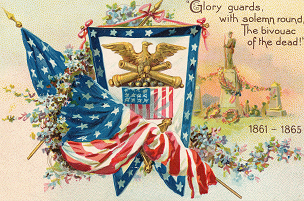
Decoration Day postcard. (NCA History Collection)
Early Years
In the waning years of the Civil War (1861–1865) and immediately afterward, communities in the North and South, Black and White, decorated soldiers' graves with floral honors on springtime "decoration days." The practice of strewing flowers on graves has been documented from Classical Roman times to western Europe in the nineteenth century.
On May 5, 1868, the Grand Army of the Republic (GAR), a politically powerful organization of Union veterans led by Major General John A. Logan — issued General Orders No. 11 or the "Memorial Day Act." This issuance formally established "Memorial Day" as a Decoration Day on which the nation would remember its war dead and decorate their graves with flowers.
In subsequent decades competition flourished to claim when and where the first such gathering occurred — in one way or another. Recent scholarship, however, points to the ladies of Columbus, GA, who in April 1866 lobbied for a clearly defined Memorial Day on which to place flowers on the graves of Civil War dead.
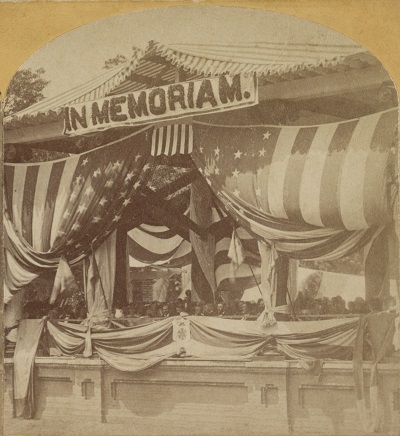 Detail of a stereograph showing President Ulysses S. Grant and General John Logan seated at the flag-draped Old Amphitheater, Arlington Cemetery, on Decoration Day, May 30, 1873. (Library of Congress)
Detail of a stereograph showing President Ulysses S. Grant and General John Logan seated at the flag-draped Old Amphitheater, Arlington Cemetery, on Decoration Day, May 30, 1873. (Library of Congress)One early memorial day account occurred in Boalsburg, PA, where a trio of women decorated the graves of fallen soldiers in October 1864. Another was held in Charleston, SC, where Black freedmen and White "Northern abolitionist allies" hosted an enormous and historically significant program on May 1, 1865, at the "Martyrs of the Race Course" cemetery where 257 Union dead were buried.
The message conveyed by this largely Black assembly honoring U.S. troops on land previously occupied by wealthy White southerners expressed the same message as Quartermaster General Montgomery C. Meigs when he appropriated the Robert E. Lee estate to become Arlington National Cemetery. Unlike that scenario, Charleston organizers could not have foreseen the temporary aspect of the racecourse site; the Army removed the dead to nearby Beaufort National Cemetery within a few years.
The idea of strewing the Civil War graves of soldiers — Union and Confederate — can be traced to Columbus, GA, whose city cemetery was in disarray. A Ladies Memorial Association formed to improve it, which included a media campaign. Secretary Mary Ann Williams' letter was published first in the local newspaper on March 11, advocating "to set apart a certain day to be observed...and be handed down through time as a religious custom of the country, to wreathe the graves of our martyred dead with flowers." Their chosen date was April 26, 1866.
However, the Mississippi city of Columbus (an ongoing source of historic confusion), held its event one day earlier than the Georgia association planned; thus it claims to being the first actual memorial day event. The Mississippi program was later immortalized in a popular poem by Francis Miles Finch, "The Blue and the Gray," and national reporting — in contemporary terms — went viral. The April 25–26, 1866, memorial day events honoring Confederate and Union dead in the South was a step toward reconciliation that reverberated nationwide, though it was predictably uncomfortable for some northerners.
General Logan was aware of these memorial efforts and their origin. In a speech given at an 1866 Independence Day celebration in Salem, IL, he spoke of the practice of floral tributes in the context of post-war Black civil rights, and compares "traitors in the south [that] have their gatherings day after day to strew garlands of flowers upon the graves of the Rebel soldiers" to a Black man "who has gained his liberty by the march and prowess of American arms, [who] shall come along with a basket of flowers to strew upon the grave of some poor loyal soldier that he shall have the right to do it."
Nonetheless, the GAR officially credited an "anonymous comrade" who had written Adjutant General Norton P. Chipman and recounted how in his native Germany it was customary to visit cemeteries and strew flowers on the graves. Then Chipman elevated it to General Logan, who added "several paragraphs" and issued it as General Orders 11.
Mrs. John Logan, a force in her husband's successful career, also took credit. In her autobiography, Mary S. Cunningham Logan presented the idea of placing flowers on soldiers' graves to her husband after returning from a Confederate cemetery in Virginia. Then recounted that General Logan felt it was "not too late for the Union men of the nation to follow the example of the people of the South in perpetuating the memory of their friends who had died for the cause which they thought just." General Logan's "adoption of the Southern custom was transparent to nearly everyone living in America in 1868," but as the author of G.O. 11, he was truly responsible for making it a national responsibility.
There will always be more to discover in the written record about the evolution of Memorial Day, but with the perspective of more than 150 years, "it may be less important to identify the holiday's first observation," observes one scholar, "than to understand how profoundly the large number of claimants to its origin indicates the ubiquity of the impulse, North and South, white and black, to commemorate the dead."
Decoration Day
The GAR order placed the ceremonial observation on May 30 — to ensure availability of "the choicest flowers of springtime" all over the country. "In this observance no form or ceremony is prescribed, but posts and comrades will in their own way arrange such fitting services and testimonials of respect as circumstances may permit." Typical programs involving GAR posts featured parading veterans and ceremonies punctuated with flags, music, and prayer, in the milieu of graves bedecked with flowers and attended by family and public alike.
The first national Decoration Day celebration took place a few weeks after the GAR promulgated its G.O. 11, on May 30, 1868, at Arlington National Cemetery, VA. Approximately 11,250 White and Black Union soldiers were buried along with about 350 Confederate soldiers; more than half were buried as unknowns. The ceremony was held around the Arlington mansion, decorated with flags and draped for mourning. Nearby was the "very profuse decoration of the main tomb where the remains of 2,111 unknown soldiers are buried." Once the home of Confederate General Robert E. Lee, the dwelling and land around it was designated a national cemetery in 1864 by General Meigs.
The commemorative program in 1868 included remarks by General and Congressman James A. Garfield (and later twentieth U.S. president), prayers, dirges, hymns, recitation of the Gettysburg Address and G.O. 11, and playing the "Star-Spangled Banner." Children of the Soldiers' and Sailors' Orphan Asylum were "deployed...to the decoration of the graves throughout the cemetery, strewing flowers and raising miniature flags over the graves." Notable Union generals and prominent Washington officials were in attendance, and employees of the federal government were permitted "free leave" to attend.
Chipman, the GAR adjutant general who oversaw the arrangements, also reported that "a small box" of flowers picked from "all the public gardens" were distributed to several regional national cemeteries: Gettysburg, PA; Fredericksburg, Poplar Grove, and Winchester, VA; and Loudon Park, MD. For posterity, the GAR published a compendium describing the hundreds of Memorial Day events its posts organized in local cemeteries, mostly in Northern states, and community enthusiasm even where only a few veterans were buried. Former Confederate states recognize memorial days on different dates from April to June.
Logan's General Orders No. 11 also urged the nation to never forget the Civil War's human cost: "We should guard their graves with sacred vigilance... Let pleasant paths invite the coming and going of reverent visitors and fond mourners. Let no neglect, no ravages of time, testify to the present or to the coming generations that we have forgotten as a people the cost of a free and undivided republic."
In 1873, New York became the first state to officially recognize the holiday. All of the other Union states recognized Decoration Day by 1890. The GAR's success at ensuring that graves of Union soldiers and sailors were attended to on Memorial Day is demonstrated by Army policy as early as 1891. If the GAR or other patriotic organizations were unable to organize a ceremony and decorations at a national cemetery, that responsibility fell to the cemetery superintendent. This remains true today; the coordination of Memorial Day gravesite traditions remains the managing agency's responsibility, and the federal government often provides miniature flags to be placed on graves.
Remembrance
The commemoration of Decoration Day, or, as it increasingly became known, Memorial Day, continued through the late nineteenth and early twentieth century as an informal patriotic holiday. After World War I, the event was expanded to honor those who died in all American wars. The twentieth-century appearance of tablets with Logan's G.O. 11 promoted this association.
The duties of the Woman's Relief Corps (WRC), the GAR auxiliary organization chartered in 1883, eventually included collecting flowers to make wreaths and bouquets, and decorating graves of the unknowns. The WRC sought to reaffirm Logan's patriotic Memorial Day message by issuing cast-iron tablets with a bas-relief portrait of Logan above the text of his G.O. 11.
In the 1920s and 1930s, the organization donated these to states for placement in prominent locations — state houses, courthouses, and schools. In a fiftieth anniversary publication, WRC reported that by 1933 its chapters had already placed thirty-five "General Logan Bronze Tablets" across the country. More were donated after that date. The tablets are found at Wood National Cemetery, WI, and Andersonville National Cemetery, GA.
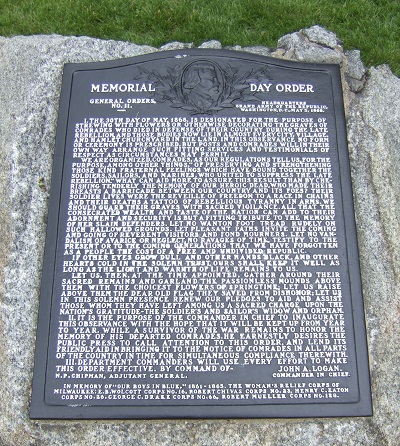 Woman's Relief Corps Memorial Day Act tablet at Wood National Cemetery. (NCA)
Woman's Relief Corps Memorial Day Act tablet at Wood National Cemetery. (NCA)The U.S. Army placed its own version of the Memorial Day Act tablets at most of the national cemeteries it developed between the world wars in urban areas, including at Baltimore, MD, and Long Island, NY. These were among twenty-eight tablets that Levering Brothers Inc. produced in York County, PA, in 1939. The design replicates the dimensions and appearance of iron tablets cast with the Gettysburg Address that the Army installed in all existing national cemeteries in 1909 as a centennial project to honor President Abraham Lincoln.
The Memorial Day Act and Gettysburg Address tablets complement a handful of official issuances the Army had installed in the late nineteenth century to orient visitors to the origin and rules of the relatively new cemeteries. These include Civil War-era bronze shields originally placed on inverted cannon "monuments" about 1873; and in 1881–1882, cast-iron tablets with the General Orders No. 80 of 1875 and the National Cemeteries Act of 1867, as well as lines of verse from the "Bivouac of the Dead."
The federal government continued to recognize Memorial Day through legislative actions. "The Congressional joint resolution approved May 11, 1950 (64 Stat. 158), has requested the President to issue a proclamation calling upon the people of the United States to observe each Memorial Day as a day of prayer for permanent peace and designating a period during each such day when the people of the United States might unite in such supplication."
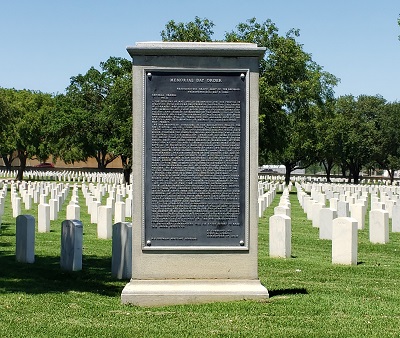 Memorial Day Act tablet the Army placed in Fort Sam Houston National Cemetery. (NCA)
Memorial Day Act tablet the Army placed in Fort Sam Houston National Cemetery. (NCA)A congressional resolution in 1966 officially recognized a century of Memorial Day events held on May 30 in Waterloo, NY, officially proclaimed by President Lyndon B. Johnson. Thus the federal government declared this location as the "birthplace" of Memorial Day. Shortly after that, the Uniform Monday Holiday Act, legislation enacted in 1968 — effective in 1971 — designated Memorial Day a national holiday and moved it from May 30 to the last Monday in May.
Most recently, to reiterate that the sacrifices of America's fallen heroes are never forgotten, in December 2000, the National Moment of Remembrance Act (PL 106-579) established the White House Commission on the National Moment of Remembrance. The commission's message to U.S. citizenry is to give "back to their country, which provides them so much freedom and opportunity" by encouraging Memorial Day activities. The commission also endorsed a National Moment of Remembrance at 3 pm local time each Memorial Day, a minute of silence for those who have died in service to the nation.
General Logan
John Alexander Logan (1826–1886) was born in Murphysboro, IL. He fought in the Mexican-American War (1846–1848), then returned home where he was admitted to the bar and elected to the Illinois house of representatives. He and Mary Simmerson Cunningham (1838–1923) married in 1855 and they would have two children. Logan's lifelong military and varied political career often overlapped. He was elected to the U.S. House of Representatives as a Democrat (1859–1862) but resigned to serve in the Civil War in which he was commissioned a brigadier general, then major general of Volunteers.
After the war he was re-elected to Congress (1867–1877), but as a Republican. Concurrently, he served as the Grand Army of the Republic (GAR) national commander for three terms starting in January 1868. In 1879, he was elected to the U.S. Senate where he served until his death. Logan is interred at the Soldier's and Airmen's Home National Cemetery in Washington, DC. VA's Fort Logan National Cemetery near Denver, CO, was named for Logan in 1889.
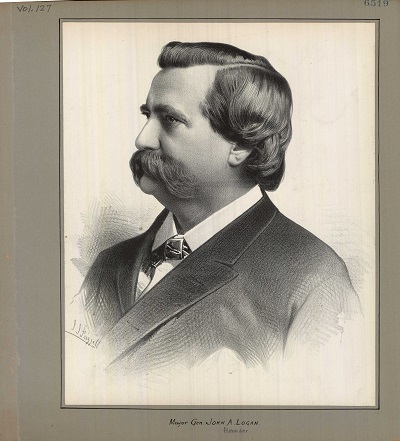 Portrait of John A. Logan. (U.S. Army Heritage and Education Center)
Portrait of John A. Logan. (U.S. Army Heritage and Education Center)The first GAR post was organized and chartered in Decatur, IL, on April 6, 1866. It quickly became the preeminent Union veterans' organization, but its original fraternal mission evolved into something more powerful. Membership peaked in 1890 with more than 400,000 members whose ranks included U.S. Presidents Ulysses S. Grant, Rutherford B. Hayes, James Garfield, Benjamin Harrison, and William McKinley. In the late nineteenth century, few private organizations — and no other veterans organization — wielded the political clout that the GAR did. The organization died out along with its last member in 1956, but its legacy is preserved by the Sons of Union Veterans of the Civil War (SUVCW), which was organized in 1881 and chartered by Congress in 1954.
Popular Literature
In addition to Theodore O'Hara's "Bivouac of the Dead," which was written after the Mexican-American War (1846–1848) but remained popular through the post-Civil War years, the country's poets penned volumes of verse that extolled sentiments associated with the remembrance of deceased veterans, and how they are honored on Memorial Day. Two poems are especially worth highlighting.
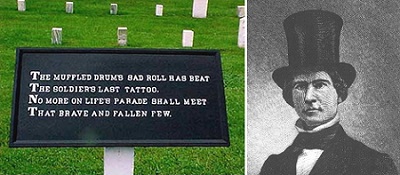 Stanzas from Theodore O'Hara's poem, 'Bivouac of the Dead.' Portrait of O'Hara.
Stanzas from Theodore O'Hara's poem, 'Bivouac of the Dead.' Portrait of O'Hara.The first is by Henry Wadsworth Longfellow, among the most popular American poets of the nineteenth-century. Published well after the end of the Civil War, his "Decoration Day" poem appeared in the June 1882 issue of The Atlantic magazine. It concludes with, "Your silent tents of green / We deck with fragrant flowers / Yours has the suffering been, The memory shall be ours."
The other is by Paul Lawrence Dunbar (1872–1906), "one of the first influential Black poets in American literature" and the son of Joshua Dunbar, a former slave who served in the U.S. Colored Troops in the Civil War and is buried in Dayton National Cemetery. The younger Dunbar wrote "Ode for Memorial Day" in 1896:
"Flowers of charity, peace, and devotion / Bloom in the hearts that are empty of strife; / ... / So with the singing of pæans and chorals, / And with the flag flashing high in the sun, / Place on the graves of our heroes the laurels / Which their unfaltering valor has won!"
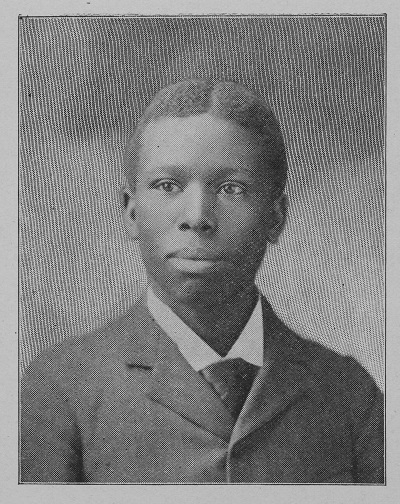 Portrait of Paul Dunbar, 1900. (New York Public Library Digital Collections)
Portrait of Paul Dunbar, 1900. (New York Public Library Digital Collections)Selected Sources
David Blight, Race and Reunion - The Civil War in American Memory (Belknap Press, 2001)
Drew Gilpin Faust, This Republic of Suffering: Death and the American Civil War (Knopf, 2008)
Richard Gardiner and Daniel Bellware, The Genesis of the Memorial Day Holiday in America (Columbus State University, 2014)
Mary Cunningham (Mrs. John A.) Logan, Reminiscences of a Soldier's Wife-An Autobiography (Scribner's Sons, 1913) Reminiscences of a soldier's wife. - Full View | HathiTrust Digital Library
John Neff, Honoring the Civil War Dead: Commemoration and the Problem of Reconciliation (University Press of Kansas, 2005)

















